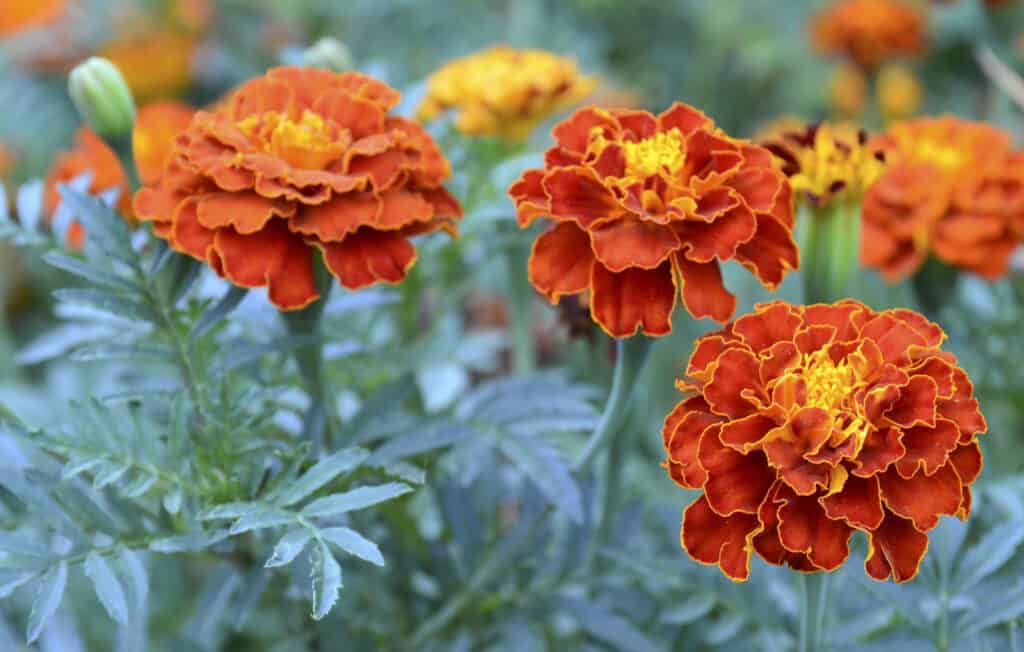October Birth Flowers: Symbolism and Meaning of Marigolds and Calendulas
Ah, October! The month of crisp air, falling leaves, and two dazzling birth flowers that paint the autumn landscape with vibrant hues – calendula and marigold. These blossoms aren’t just your average garden variety; they hold rich histories and captivating symbolism that make them truly special.
In this article, we’ll delve deeper into the world of these October birth flowers, exploring their folklore, uses, and the beauty they add to the autumn landscape. So, let’s embark on a colorful journey into the heart of calendula and marigold!
What Are Calendulas?
Calendulas, scientifically known as Calendula officinalis, are vibrant and versatile flowering plants that belong to the Asteraceae family. These annual or perennial herbs are cherished for their striking appearance and various practical uses.
Classification
Calendulas belong to the plant family Asteraceae, which includes daisies and sunflowers. Within this family, they are part of the Calenduleae tribe, a group of flowering plants characterized by their bright ray and disc florets. The scientific name “Calendula officinalis” reflects their traditional use in medicine.
Appearance
Calendulas are easily recognizable by their distinctive appearance. They typically grow to a height of 12 to 24 inches and feature lance-shaped, aromatic leaves covered with fine hairs. The most striking feature is their daisy-like flowers, which come in a spectrum of warm colors such as yellow, orange, and deep maroon. These flowers consist of ray florets that surround a central disc of tightly packed tubular florets, creating a captivating contrast in texture and color.
Varieties
Calendulas boast a variety of cultivars, each with unique characteristics. The most common types include:
- Calendula officinalis: The traditional calendula, with bright yellow or orange petals, is a popular choice for gardens and herbal remedies.
- Calendula ‘Bon Bon’: This compact variety produces abundant double flowers in shades of orange and apricot.
- Calendula ‘Indian Prince’: Known for its deep maroon petals and dark centers, this variety adds a touch of drama to the garden.
- Calendula ‘Pacific Beauty’: Offering a mix of vibrant colors, including yellows, oranges, and creams, this variety is a favorite for cut flower arrangements.
Native Habitat
Calendulas are native to Southern Europe, particularly regions around the Mediterranean. They thrive in mild climates and are well-adapted to both full sun and partial shade. However, these adaptable plants have been cultivated worldwide due to their ornamental value and medicinal properties. They can be found in gardens, meadows, and even in pots on windowsills.

©Yulia_B/Shutterstock.com
October Birth Flowers: The Meaning and Symbolism of Calendulas
Calendula flowers, with their vibrant colors and rich history, hold special meaning and symbolism that make them a meaningful gift for various occasions. Let’s explore the significance of calendula flowers, including their role as October birth flowers, their symbolism, and the appropriate special occasions to present these cheerful blooms.
October Birth Flowers
Calendula flowers are the designated birth flowers for the month of October. Birth flowers are floral symbols associated with each month and often hold unique meanings and significance. For individuals born in October, calendulas serve as a personalized and thoughtful gift that represents their birth month. Gifting calendulas during this time can convey a sense of recognition and celebration of the recipient’s birth and individuality.
Symbolism of Calendula Flowers
Calendula flowers carry a range of symbolism and meanings, making them a versatile choice for various occasions. Some key symbolic associations include:
Warmth and SunshineCalendulas are known for their bright and warm colors, primarily shades of yellow and orange. These colors symbolize the sun’s energy and warmth, evoking feelings of happiness, positivity, and vitality. Gifting calendulas can be a way to bring a ray of sunshine into someone’s life, brightening their day.
Protection and HealingIn traditional herbal medicine, calendula flowers have been used for their healing properties. They are known for their soothing and anti-inflammatory effects. As such, they symbolize protection and well-being. Presenting calendulas can convey wishes for the recipient’s health and healing during times of illness or recovery.
Respect and AdmirationThe name “calendula” is derived from the Latin word “calendae,” meaning “little calendar” or “little clock.” This name suggests a sense of order and precision, symbolizing respect and admiration for someone’s punctuality, organization, or commitment to a structured life.
Remembrance and CelebrationCalendulas are sometimes associated with commemorating and celebrating loved ones. Their vibrant colors and fresh fragrance can be a fitting choice for honoring the memory of someone special or marking important milestones, such as anniversaries or memorial events.
Special Occasions for Giving Calendula Flowers
Calendula flowers can be a meaningful gift for a variety of special occasions, thanks to their versatile symbolism and cheerful appearance. The following are some appropriate occasions for presenting calendulas.
BirthdaysAs October’s birth flower, calendulas make a thoughtful and personalized birthday gift. They convey well wishes and celebrate the recipient’s unique qualities.
Get Well SoonCalendulas’ healing symbolism makes them an ideal choice for wishing someone a speedy recovery. Gifting these flowers can offer comfort and support during illness or after surgery.
AnniversariesThe vibrant colors of calendula flowers can symbolize the warmth and vitality of a lasting relationship. They are a great choice for marking wedding anniversaries or other significant milestones in a partnership.
Thank YouCalendulas can express gratitude and appreciation in a vibrant way. Whether it’s to say thank you to a friend, colleague, or family member, these flowers can convey your heartfelt thanks.
Memorial ServicesThe remembrance symbolism of calendulas makes them suitable for memorial services or events honoring the memory of a loved one. Their bright colors can add a touch of positivity and celebration to such occasions.
CongratulationsCalendulas can be used to congratulate someone on their achievements or milestones. Whether it’s a graduation, promotion, or any noteworthy accomplishment, these flowers convey happiness and success.
Calendula flowers, as the October birth flowers, hold a special place in the world of symbolism and meaningful gestures. Their warm colors, healing symbolism, and versatile meanings make them a fitting choice for various special occasions.
What Are Marigolds?
Marigolds, scientifically classified as Tagetes, are a vibrant and versatile group of flowering plants celebrated for their striking appearance and numerous uses.
Classification
Marigolds belong to the Asteraceae family, which encompasses various other well-known flowers like sunflowers and daisies. Within this family, they are part of the Tageteae tribe. Scientifically, they are divided into two main species: Tagetes erecta (African marigold) and Tagetes patula (French marigold). These species are further divided into numerous cultivars with distinct characteristics.
Appearance
Marigolds are easily identifiable due to their unique appearance. They typically range in height from six inches to three feet and feature pinnately divided leaves with an aromatic scent. The most notable feature is their vibrant flowers, which come in a rich palette of colors, including shades of orange, yellow, and red. The flowerheads are often globe-shaped and comprised of numerous petals, creating a bold and eye-catching display.
Varieties
Marigolds offer a diverse array of cultivars, each with its own charm and characteristics. Some popular varieties include:
- Tagetes erecta (African marigold): Known for their large, showy flowers, African marigolds are available in shades of deep orange and yellow, making them a striking choice for gardens and floral arrangements.
- Tagetes patula (French marigold): These marigolds are more compact and are available in a wider range of colors, including reds and bi-color combinations. They are often used as bedding plants.
- Tagetes tenuifolia (signet marigold): These marigolds have finely divided leaves and small, delicate flowers in shades of yellow and orange. They are prized for their ornamental and culinary uses.
Native Habitat
Marigolds are native to the Americas, with their origins traced back to regions of Mexico and Central America. They have a long history of cultivation by indigenous peoples, dating back to ancient civilizations like the Aztecs and Mayans. Over time, marigolds have been introduced to various parts of the world, and their adaptability has made them a favorite in gardens across diverse climates.

©iStock.com/svf74
October Birth Flowers: The Meaning and Symbolism of Marigolds
Marigold flowers, with their radiant hues and rich cultural history, are not just a feast for the eyes but also bear deep meaning and symbolism. Let’s delve into the significance of marigold flowers, their role as October birth flowers, and explore the various special occasions where presenting marigolds can convey heartfelt sentiments.
October Birth Flowers
Marigold flowers hold the distinction of being one of the birth flowers for the month of October. Birth flowers are floral symbols associated with each month, and they often carry unique meanings and significance. For those born in October, marigolds become a symbolic representation of their birth month. Gifting marigold flowers during this time can be a meaningful way to celebrate the recipient’s birth and convey a sense of recognition.
Symbolism of Marigold Flowers
Marigold flowers are rich in symbolism and meanings that make them an excellent choice for various occasions. Some of the key symbolic associations include the following.
Vibrancy and PositivityMarigolds are renowned for their bright and cheerful colors, primarily shades of yellow and orange. These colors symbolize vibrancy, positivity, and the radiant energy of the sun. Gifting marigolds can convey warm wishes and bring a burst of joy into the recipient’s life.
Friendship and LoyaltyIn different cultures, marigolds are often associated with friendship and loyalty. They are given as tokens of affection and camaraderie, making them a thoughtful choice for expressing appreciation and strengthening bonds with friends.
Resilience and CourageThe robust and hardy nature of marigold plants symbolizes resilience and courage. They thrive in various conditions and are often associated with the ability to overcome challenges. Gifting marigold flowers can be a way to encourage and support someone facing difficulties.
Honoring the DeceasedIn some cultures, marigolds are used in funerary practices and altars to honor deceased loved ones. Their bright colors are believed to guide spirits and provide comfort to the departed, making them a suitable choice for memorial services.
Special Occasions for Giving Marigold Flowers
Marigold flowers can be a meaningful gift for a variety of special occasions, thanks to their versatile symbolism and vibrant appearance. The following are some appropriate occasions for presenting marigolds.
Birthdays
As October’s birth flowers, marigolds make a thoughtful and personalized birthday gift. They symbolize the essence of the birth month and convey well wishes for the recipient’s special day.
Friendship DayMarigolds, with their symbolism of friendship and loyalty, are an ideal choice for celebrating Friendship Day or showing appreciation to a dear friend.
CongratulationsWhen someone achieves a milestone or accomplishes a significant goal, marigold flowers can be used to convey congratulations. Their bright colors symbolize the joy of success.
Get Well SoonThe positive and vibrant symbolism of marigolds makes them a suitable choice for wishing someone a swift recovery during illness or after surgery. They can offer comfort and encouragement.
WeddingsMarigolds can be incorporated into wedding bouquets and decorations, symbolizing the vibrant journey of the couple and their commitment to each other.
Memorial ServicesMarigolds are used in some cultures to honor and remember loved ones who have passed away. Their bright colors bring a touch of positivity to memorial services.
Cultural CelebrationsMarigolds play a significant role in various cultural celebrations and festivals, such as Diwali in India and Dia de los Muertos in Mexico. Gifting marigolds during these events can show respect for cultural traditions and customs.
Marigold flowers hold a special place in the realm of symbolism and meaningful gestures. Their vibrant colors, associations with positivity, friendship, and resilience make them an excellent choice for various special occasions.

©Andrei Dubadzel/Shutterstock.com
Where Did The Symbolism Behind Calendulas and Marigolds Come From?
The symbolism of calendulas is closely tied to their historical uses and attributes. The name “calendula” is derived from the Latin word “calendae,” which means “little calendar” or “little clock.” This name reflects the belief that calendula flowers would bloom at the beginning of each month, serving as a natural timekeeper. As such, calendulas became symbolic of order, precision, and the passage of time.
Calendulas have a long history of use in folk medicine, particularly in Europe. They were treasured for their healing properties and were used to treat a variety of ailments, including skin conditions and digestive issues. The flowers’ bright and cheerful appearance also contributed to their symbolism of health and protection. People often placed calendula flowers under their pillows to ward off nightmares and ensure restful sleep.
Likewise, the symbolism associated with marigolds has deep roots in various cultures around the world. Marigolds are believed to have originated in the Americas, particularly in Mexico, where they held a sacred place in Aztec and other indigenous civilizations. The Aztecs referred to marigolds as “cempasúchil” and used them in various rituals and ceremonies. They believed that the vibrant colors and strong fragrance of marigolds could guide the spirits of the deceased during Dia de los Muertos (Day of the Dead) celebrations, which continue to this day.
In India, marigolds are highly regarded and are often used in religious ceremonies and festivals. They symbolize purity and auspiciousness. The bright orange and yellow marigolds are associated with the Hindu deity Lord Vishnu and are used to honor gods and goddesses during prayers and rituals. Marigold garlands are also used as offerings in temples and adornments for weddings and other celebrations.









